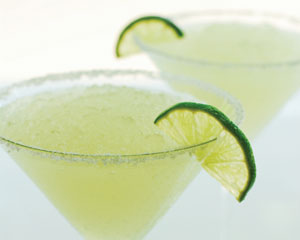About 60 of the country’s professional food writers gathered last week in Santa Fe, New Mexico for the annual conference of the Association of Food Journalists. (AFJ) That means seminars on subjects such as Native American Cuisine, Chocolate & Chilies, and Memory and Experience in Food Writing. It also means long hours at tables laden with the best food this city’s imaginative chefs have to offer. Oh yeah, it also means tequila….lots of it.
 One day Al Lucero, a jovial gent who happens to own Maria’s
New Mexican Kitchen, led the group on an hour-long tequila tasting and
tutorial. (This tempting photo is from Variety.com which offers an unusual margarita recipe.) I’ve never been a fan of that particular spirit…finding that gin has
far more fragrance, and bourbon far more spunk. But I went along for the ride
and discovered some fascinating facts.
One day Al Lucero, a jovial gent who happens to own Maria’s
New Mexican Kitchen, led the group on an hour-long tequila tasting and
tutorial. (This tempting photo is from Variety.com which offers an unusual margarita recipe.) I’ve never been a fan of that particular spirit…finding that gin has
far more fragrance, and bourbon far more spunk. But I went along for the ride
and discovered some fascinating facts.
**Tequila can only be made in Mexico, where the government strictly regulates its production.
**Only blue agave can be used to make tequila. It’s a relative of the lily and the aloe vera plant.
**The plant is harvested, hacked up, steamed, mashed, strained, and double distilled. Yeast is added, nothing more.
**If the bottle says “Silver,” it’s 100 % agave, taken straight from the still to the bottle. If it says “Reposado,” it’s 100 % agave that’s been aged for 60 days in oak barrels. “Anejo” is 100 % agave that’s been aged a year in oak barrels.
**If the bottle says “Mixto,” it’s 51% agave and 49 % sugar water.
**Oak barrels give the older tequilas a hint of yellow-gold color. On the other hand, Jose Cuervo’s Mixto is colored by a caramel mixture, according to Lucero, who hastened to add that Jose Cuervo Mixto is a high-quality product that makes an excellent margarita.
**It's a no-no to use a blender on a margarita unless fruit is involved; and the less said about margaritas in which fruit is involved, the better.
Lucero, who says he serves 3,000 hand-shaken margaritas a week at Maria’s, also weighed in on the origin of the margarita. He insists that the drink was concocted in Palm Springs for Bing Crosby and his cronies. Or, to be more precise, the women who hung out with Bing Crosby and his cronies.
According to Lucero, the gents were accustomed to drinking tequila as “a shot, a lick and a bite,” meaning, down it, lick salt off your fist and chomp a lime wedge. But, as more wives and girlfriends starting showing up at the increasingly popular desert hideaway, bartenders needed to come up with something more, er, ladylike. “An enterprising bartender came up with the idea of shaking tequila with Cointreau,” said Lucero, who added that this is his favorite explanation, though his book "The Great Margarita Book" offers 30 or so other versions of the creation story.
Our group got to sample Maria’s 100% Agave House Margarita at a cocktail party featuring food from 10 of the city’s best restaurants. Served, with crushed ice, in a balloon-style stem glass with a heavily salt-encrusted rim, it was made with Jose Cuervo Tradicional, Bols Triple-Sec and freshly squeezed lemon juice. I wasn’t crazy about the potion, finding it too sharp for my tastes. During the tasting that Lucero led earlier in the day, I discovered that I greatly prefer anejo tequila (aged in wood for a year) to silver (straight from the still) or reposado (which is what Cuervo Tradicional is). I also greatly prefer fresh lime juice to lemon juice.
However, one margarita does not Maria’s New Mexican Kitchen
make. The drink menu is an eight-page affair with more than 170 different
margaritas, including the Paradiso which is made with
El Tesoro anejo tequila, Grand Marnier’s Special Anniversary Cuvee and lemon
juice. It costs $48 a pop.

Comments